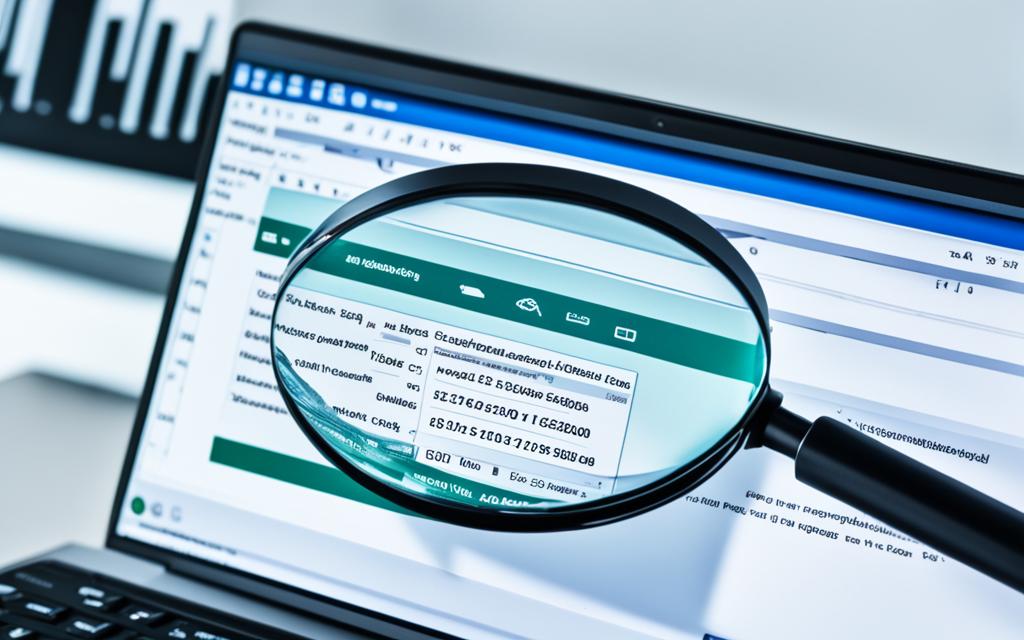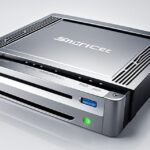Table of Contents
SSDs are getting more popular, and it’s vital to know how to manage their storage. Many find it tough to figure out what eats up their SSD space, especially with sizes typically between 128 GB and 512 GB. It’s important to use space wisely to keep your SSD running smoothly.
This guide is here to help you find and clear out what’s taking up space. By understanding how SSDs differ from older Hard Disk Drives (HDDs), you can plan better and keep your device in top shape12.
Key Takeaways
- Solid State Drives often come in smaller capacities compared to traditional Hard Disk Drives.
- Effective SSD management is essential for maintaining optimal device performance.
- Tools like Windows Storage and MiniTool Partition Wizard assist in monitoring disk space usage.
- Identifying hidden files can significantly contribute to freeing up SSD space.
- Regular assessments of disk space can preempt performance issues.
Understanding the Significance of SSDs
Technology keeps advancing, making storage more crucial. Solid-state drives, or SSDs, change how we store data. They’re a big leap over the older hard disk drives (HDDs). Let’s look at what sets SSDs apart, their advantages, and talk about their sizes and some limitations they come with.
What Makes SSDs Different from HDDs?
SSDs are a game changer in storage, mainly because they use flash memory, not spinning disks. This means they work way faster, making your computer start quicker and run apps smoothly. They’re also tougher and more reliable since they don’t have moving parts. This makes them great for people who are always on the go and need their data safe.
The Benefits of Using SSDs
The perks of using SSDs are huge. They boost how well your computer works and cut down on how long it takes apps to start. SSDs are smart, too. They can use tricks like TRIM and garbage collection to manage space better by finding data blocks that aren’t being used. This smart management means you can do more in less time. With everyone wanting faster access to their data, SSDs are becoming more popular.
Common Sizes and Their Limitations
SSD sizes usually range from 120 GB to 512 GB. Bigger SSDs exist, but they’re not common for everyday use. Smaller SSDs can fill up fast, so it’s important to keep them tidy. You can free up space by deleting apps you don’t use and tuning settings. For example, turning off System Restore or Hibernation can help save space34. But, finding the right balance between speed and size is key. High-capacity SSDs, like the Kingston KC3000 NVMe M.2 SSD with its amazing speed, are perfect for those who need the best performance3.
How to Find What’s Taking Up Space on SSD
It’s crucial to know what’s eating into your SSD space for it to work well. Start by using the Windows tools designed for SSDs. They make it easy to see and manage what’s stored. This way, spotting and removing large files that take up too much space becomes simple.
Utilising Windows Built-in Tools
For checking SSD storage, go to “Settings > System > Storage.” This will show how space is used on different drives. It helps find and get rid of big files you don’t need. Regularly clear out junk and temp files to save more space5.
Setting your Recycle Bin to automatically clear can help too5. Turning off system restore and Hibernate mode also frees up space, as both take up more room than you might think5. Removing programs you no longer use via the Control Panel can also make your SSD run better.
Employing Third-Party Disk Space Analyser Software
Sometimes, the built-in tools might not be enough. Then, using software like WinDirStat or TreeSize is smart. These tools give a deeper look into your SSD. They show exactly which files or folders are the biggest. This info helps decide what stays and what goes. Plus, they’re easy to use, whether you’re a newbie or a pro at managing space6.
With these tools, keeping your SSD in top shape is easier. They help make sure your device is running smoothly and efficiently6.
Inspecting Hidden Files and Folders
When it comes to managing your SSD storage, knowing about hidden files is key. Many might not know that hidden files can add a lot to storage clutter. This clutter can slow down your system. By learning how to see hidden files on Windows, you can keep your SSD clean. This helps in making your device run better.
Why Hidden Read Files Matter
Hidden files can use a lot of space without you knowing. They often are found in parts of your system you don’t usually look at. These files can come from system backups, apps, or temporary files that weren’t deleted. Since SSDs have less space than hard drives, it’s important to check for these files often. This prevents your system from slowing down. Knowing why there are hidden files can help you find extra storage. This makes your system more efficient.
Steps to Show Hidden Files on Windows
To see the hidden files on your SSD, just follow these easy steps:
- Open File Explorer.
- Click on the “View” tab at the top menu.
- Check the option for “Hidden items” to show hidden files, folders, and drives.
- Use the search to sort by size. This helps you see which hidden files take up the most space.
These steps don’t just help in viewing hidden files in Windows. They also improve how you manage storage. This lets you find files you didn’t know were using up space. For more about how operating systems manage files, read this article about computer kernels. It explains their role in making systems run better. Knowing about hidden files is vital for keeping your SSD efficient and making sure there’s enough room for your important apps.
By following these steps, you’ll know more about file management. This helps keep your computer running smoothly7.
Common Space-Hogging Offenders
Your SSD’s efficiency can take a hit from files that eat up a lot of space. Large applications, temporary files, and system restore points are the main culpr face. Games and multimedia files, especially with their backups, can quickly fill up SSDs. For example, just the Windows folder can use a lot of space on the C: drive. The hiberfile.sys file alone can be a huge 76.7GB, and the pagefile.sys can take another 12GB. This shows that it’s very important to keep an eye on and manage your space well89.
It’s crucial to regularly get rid of junk files and turn off things like System Restore to fight against these large files on your SSD. Many don’t use automatic cleanup tools that could really help free up SSD space. The Disk Cleanup tool, for instance, can clear out unneeded temporary files. There are also advanced tools that find and help manage large files, making it easier for those who want to keep their digital space clean9.
Taking an active role in checking your storage space can make sure your SSD works the best it can. Start by checking the files you’ve downloaded, use tools to squish files down, and regularly move files you don’t often use to an external drive. By keeping on top of the things that take up too much space, you can have a smooth computer experience without worrying about running out of SSD space9.
FAQ
How can I find out what’s taking up space on my SSD?
To find out what’s using space on your SSD, look at the Windows “Settings > System > Storage.” This shows how your storage is used, helping you spot big files. Tools like EaseUS Partition Master offer detailed analysis of what’s on your SSD. This makes it easy to manage your SSD storage.
What are the key differences between SSDs and HDDs?
SSDs and HDDs differ mainly in how they work. SSDs use flash memory, making them quicker and more durable than HDDs. Since HDDs use spinning disks, they’re slower. SSDs speed up data access and start-up times, boosting your computer’s speed.
What advantages do SSDs offer over traditional storage?
SSDs boost your computer’s speed, cut down on loading time for programs, and are better at handling bumps and shocks. Their quickness improves how fast you can access data and how quickly your computer starts up. This is key for keeping up with today’s computing demands.
What are the common sizes of SSDs and their limitations?
SSDs usually come in sizes from 120 GB to 512 GB. While they’re faster and more reliable than HDDs, their smaller sizes may limit how much you can store. It’s important to carefully manage what you keep on your SSD to avoid running out of space.
Hidden files might be using up space on your SSD. To see them, go to File Explorer, click “View,” then “Show hidden files, folders, and drives.” By doing this, you can find files you didn’t know were there, helping you better manage your storage.
What files typically take up the most space on my SSD?
Big apps, temporary files, games, media files, and system backups often use lots of SSD space. Regular clean-ups, turning off things you don’t need, and emptying the Recycle Bin can help keep your SSD working well and free up space.
Source Links
- https://www.partitionwizard.com/clone-disk/disk-space-analyzer.html – What Is Taking up Space on PC? Top 7 Disk Space Analyzers Help! – MiniTool Partition Wizard
- https://www.ibm.com/think/topics/hard-disk-drive-vs-solid-state-drive – Hard Disk Drive (HDD) vs. Solid State Drive (SSD) | IBM
- https://www.kingston.com/en/blog/pc-performance/full-ssd-solutions – What to Do if Your SSD Is Full
- https://www.easeus.com/computer-instruction/free-up-space-ssd.html – How to Free Up Space on SSD in Windows 10/8/7
- https://www.diskpart.com/articles/how-to-see-whats-taking-up-space-on-ssd-1503.html – How to See What’s Taking Up Space on SSD?
- https://community.spiceworks.com/t/hard-drive-says-its-full-but-i-cant-find-files-that-large-what-am-i-missing/597742 – Hard Drive says it’s full, but I can’t find files that large. What am I missing?
- https://www.easeus.com/computer-instruction/what-is-taking-up-space-on-my-hard-drive.html – Solved: What Is Taking Up Space on My Hard Drive in Windows 11/10/8/7
- https://askleo.com/wheres_my_disk_space_going/ – Where’s My Disk Space Going?
- https://www.pctips.com/free-up-space/ – How to FREE Up More than 100GB+ Of Disk Space








